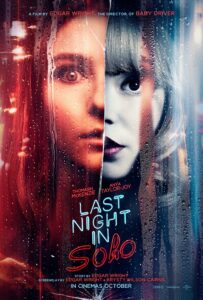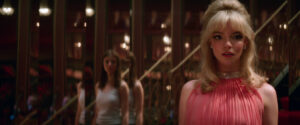Film Review: The Aesthetic Wonders of “Last Night in Soho” Ultimately Fade
Written by: Adam Vaughn | October 28th, 2021

Last Night in Soho (Edgar Wright, 2021) 2½ out of 4 stars.
Edgar Wright’s latest film has much to be admired, and it’s with a heavy heart that I offer major criticism about the film’s abrupt shift halfway through the story. Wright starts with an amazing premise—a modern-day “Alice in Wonderland” fantasy-adventure with a stunning 1960s London backdrop—that seemingly gets thrown to the side to make way for worn-out horror/thriller conventions, succumbing to a generic structure that pulls the audience out of a once-mesmerizing experience. When Last Night in Soho is at its peak, it is truly a marvelous period piece, but once the fine-tuned storytelling starts to fade, the result is a disappointing muddle.
The movie follows Eloise, or “Ellie” (Thomasin McKenzie, Jojo Rabbit), a fashion student, who is an outcast from the rest of her class, though there is one boy (Michael Ajao, Attack the Block) who wants nothing but to be her friend. As Ellie decides to live off-campus, she finds a quaint and secluded hotel, where every night she is able to transport herself back to the 1960s and witness the dazzling lifestyle of Alexandra, or “Sandie” (Anya Taylor-Joy, Netflix’s The Queen’s Gambit series). In contrast to her glamour, Sandie suffers from the degrading condition of trying to survive under the controlling power of her lover and manager Jack (Matt Smith, His House). As Ellie unravels more and more of Sandie’s troubles, she also starts to lose grip of her sanity, leading up to one gruesome and dark discovery after another.

Initially, I was absolutely dazzled and sold by the clever concept, its impressive style, and genuine characters found in the ‘60s setting, as well as the lovable and sincere nature of McKenzie’s Ellie. Wright launches us into a mysterious fable where the viewer is transported to a new world and never wants to leave. The film’s visual effects of Ellie and Sandie brought together through mirror and window reflections adds especially to Wright’s vision. By far the best parts of Last Night in Soho to be admired are in the first half of the film.
Last Night in Soho’s tragic flaw is that, about the time that its big reveal takes place, Wright rushes to make narrative ends meet by the film’s conclusion. The result is a few overused horror tropes, generic sequences, and a plot twist that, while interesting, gets completely enveloped in the clichéd tone the film clings to by that time. We lose all the sights and sounds of the ‘60s, twisting a fantastic and supernatural experience into a modern whodunit murder account. The film’s latter half almost seems as if it wishes to wrap up its ideas and have the heroine save the day rather than continue to explore the world built around it.

When Wright is focused on his presentation of premise and setting, Last Night in Soho is a truly marvelous and unique experience. But much to my disappointment, the story eventually spirals into images and plot points that make it a more conventional experience than it initially was. Ironically, it’s as if Wright wanted to try to please the masses this Halloween month by adding in several unnecessary frights, when in essence these scenes of terror never truly feel like they fit the story’s overall message. In some ways, most of what can be admired in Last Night in Soho can be displayed and admired by simply watching the film’s trailer, and not looking too deep into its full content.

